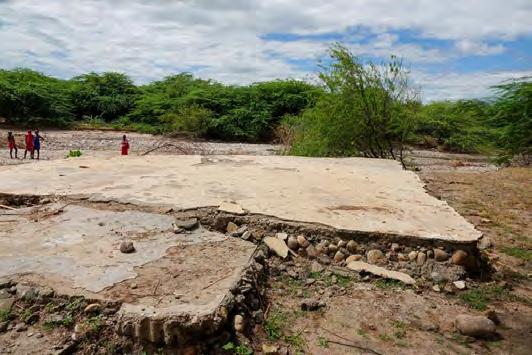
4 minute read
LIFE AFTER THE FLOODS – KENYAN FARMERS FACE BLEAK FUTURE
More than 168,000 acres of crops have been destroyed by recent unprecedented floods, according to Kenya’s government. As a food crisis looms, MAF’s Jacqueline Mwende spends time with cut-off farming communities in both southern and northern Kenya where MAF has been delivering aid.
In the wake of Kenya’s devastating floods from March to May 2024, which saw historically high water levels turn northern Kenya’s Chalbi Desert into mud for the first time, the lives of farmers and their families have been turned upside down.
More than 168,000 acres of crops have been destroyed by unprecedented floods, according to Kenya’s government. As a food
crisis looms, MAF’s Jacqueline Mwende spent time with cut-off farming communities in both southern and northern Kenya where MAF has been delivering aid.
In the wake of Kenya’s devastating floods from March to May, which saw historically high water levels turn northern Kenya’s Chalbi Desert into mud for the first time, lives of farmers and their families have been turned upside down.
Rural roads have been washed away or turned into dangerous mudslides. As a result, cutoff communities can only be reached by plane.
In Pakase, Shompole – a southern pastoralist community near the Tanzania border – over 350 families saw their homes, livelihoods and community buildings washed away by a swollen river.
Thousands of livestock are dead. Even elephants have drowned.
Letoi witnessed first-hand the destruction of her own home:
‘We were still asleep at 9am on Monday when we heard the ominous sound of rushing water approaching our home. When I looked outside, I saw a powerful torrent moving towards us. I managed to grab my children and move to higher ground.’
— Letoi - flood survivor and beneficiary of aid delivered by MAF
MAF has been partnering with World Relief International – an NGO which has been supplying water purification tablets, jerry cans to store clean drinking water, mosquito nets, and feminine hygiene products to the afflicted.

M AF’s flight from the capital Nairobi to Shompole Airstrip has given the team access to some of the worst hit areas:
‘WE FEEL EVEN MORE ISOLATED’
With many roads washed away, essential deliveries and logistics are made infinitely easier with MAF, says World Relief International Kenya Country Director Oliver Otsimi:
‘We are grateful for our partnership with MAF. MAF’s flight has eased logistics, saving a lot of time.’
On the other side of the country in the far north near the Ethiopian border, pastoralist communities in Ileret Village, Marsabit County are equally devastated.
In response, MAF – in partnership with Food for the Hungry and Sign of Hope – spent two days delivering over 1,300kg of essential supplies and transporting ten aid workers.
H ungry, homeless farming families –who are at risk of preventable diseases from contaminated water – benefit from food supplements, sleeping mats, blankets, mosquito nets, soap, jerry cans and medical supplies.
Given its extremely remote location in the far north of the country, Ileret Village was already hard to access before the floods, says Sign of Hope’s field officer James:
‘We are located in the far corner of Kenya, which is extremely hard to reach, but these floods have made us feel even more isolated.
‘Many communities in Ileret have been forced to permanently relocate due to the flooding, so we are immensely grateful to receive all this assistance.’
— James – Sign of Hope’s field officer & MAF partner
THE DEVASTATING COST OF CLIMATE CHANGE
With sub-standard infrastructure either washed away or caked in mud, and swathes of usually arid wilderness now under water, Kenya’s remote southern and northern farming communities could be cut off for months.
Kenyan MAF pilot Amos Simiu – who regularly flies over northern Kenya’s Chalbi Desert -has never seen anything like it:
The whole time I’ve been flying here, I’ve never seen water on the desert. I’ve never seen water here before, but right now it is a lake as far as you can see.’

According to Associated Press, Kenya’s government has called the events:
‘A clear manifestation of the erratic weather patterns caused by climate change.’
Kenya’s opposition are calling for better preparedness for climate change disasters, improved weather forecasting and sustainable land management.
Climate change experts ‘World Weather Attribution’ claim that climate change made Kenya’s devastating floods twice as likely and 5% more intense.
Their recent study also found that further global warming would increase the frequency and intensity of future floods (source: Associated Press).
Please stand with us and lift these farmers up in prayer.








